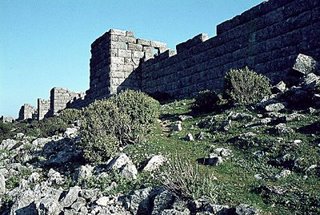I recently acquired a copy of Ancient Greek Fortifications 500-300 BC, by Nic Fields, "a freelance author and researcher based in south-west France" (lucky Dr Fields). "This book", says the blurb, "details the construction and ongoing development of the defences that protected some of the most illustrious sites in Greece during the most famous period of its history."
I beg to differ.
The already-short book (it has 64 pages, and copious illustrations, many full-page) begins with a three-page "Chronology of major events". The only problem is that there's almost no sign of "the construction and ongoing development" of Greek fortifications here. Out of 132 date entries, I found only 21 that were relevant, chiefly through mentioning a siege or a capture (e.g., "332 BC sieges of Tyre, Gaza"), and only three that actually recorded the construction of a fortification (Athens twice, Kassandreia, and Thessalonika); none mentioned ongoing development.
The fortress of Gyphtokastro (Attica, Greece) guards the Kaza pass over the Mount Parnitha range, which was the main route from Athens to Thebes. The north wall stands to its original height of about 6m; the towers survive to about 8m, and may originally have been closer to 10m. (Each course of masonry is about 70cm high, and the average stone block is 2m long!)
A chapter on "Building Methods" is a good start, but Dr Fields spouts technical terms without explaining them: "ashlar blocks", anyone? Okay, I will grant that Wikipedia comes to the rescue for this one, but what about "socle"? The one-page Glossary at the back (p.63) isn't much help; it contains only 15 terms – like "Palisade: Barrier constructed from wooden stakes, which are positioned vertically in the ground" – and uses only half the page. (A socle, by the way, is a stone-built plinth designed to provide a solid foundation for a mud-brick wall, and could stand a metre or so high.)
The main chapter, entitled "Fortifications", is simply a description of four different sites (Athens, Gyphtokastro, Mantineia, and Messene), with briefer comments on 'Other fortifications' (Aigosthena, Eleusis, Eretria, Phyle, Sounion). The sites were perhaps selected to match Dr Fields' photo collection, and that's no bad thing. But we get no sense of the promised "ongoing development" of fortifications.
The third chapter, "Nature of conflict and society", discusses infantry combat and the hoplite phalanx at great length, leaving a single page on "siegecraft" (half of p.50 and half of p.51) and a half page (p.52) on "non-torsion catapult". The mention of catapults is interesting, in the light of the tables that pop up at random intervals in the text. On p.20, there's a table of "Calibrations of bolts for bolt-shooter", with no apparent tie-in to the text. (The index confirms that this is the only mention of "bolt-shooters and bolts" in the book.) Here, the reader will learn that "1-cubit" equates to "1 cubit (pechys - 462.4mm (18.21in.)", though what he or she is supposed to do with that knowledge is unclear. The catapult, invented in 399 BC, just squeezes in at the tail-end of Dr Fields' time-scale (500-300 BC), but doesn't really figure in the text. Several photo captions take it for granted that towers were for artillery and the painting on p.39 of a tower shows catapults inside. (Though, without bows or springs, they wouldn't have been very effective!)
All in all, I'm left with the feeling that a great opportunity has been missed. The average reader will surely be left bemused by the whole subject. On p.52, there's a table of "Engines of war", listing seven dates and seven towns. The book, I think, can be summed up by one of these seven entries, which hints at some action at Oinoe in 431 BC ("Thucydides 2.18.1 - mechanai, possibly battering rams"); a glance at the index shows that Oinoe appears on p.28, where we read that "the fortified Attic deme of Oinoe (Myoupolis) had been walled by the start of the Peloponnesian War at the latest (Thucydides 2.18.2)"; and, if we check the all-important Chronology, we find "431 BC ...", no mention of Oinoe!
So, is this book about "the construction and ongoing development of the defences that protected some of the most illustrious sites in Greece"? I don't think so.

So you liked it then?
ReplyDelete:-)
Just sitting on the fence, as usual. ;-p
ReplyDeleteI think you were right about him building a book around his photo collection.
ReplyDeleteAncient Sparta was famous for being the only city state in mainland Greece that had no walls, but Sparta aside, the Greeks took great care in putting up defences for its citizens.
ReplyDeleteNic Fields looks at the development of these walls, from the famous defences of Athens and Mantinea to the financing, labour, planning, building materials and masonry styles needed for the defence of the City-State. Along the way he discusses the manning of these walls, as well as conveying information on the size of ammunition needed for the catapults.
Towards the end of the book he provides a series of 'Case Studies' which look at how these sites were defended during times of war, using the siege of Syracuse, Plataia, and Mantinea as examples.
Good but very basic and unimaginative colour plates, photographs of the sites as well as maps help complete the book.
This book could have been a much better introduction to the subject, but it loses its focus towards the end, as the author goes on to discuss unrelated topics like Hoplite warfare and the phalanx. The writing can get rather dry sometimes.
Generally speaking the rest of the book is well written and informative. I can imagine that students of Ancient Greece will find this book rather useful.